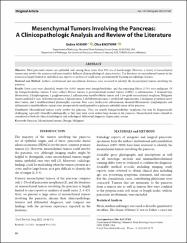| dc.contributor.author | Aşkan, Gökçe | |
| dc.contributor.author | Baştürk, Olca | |
| dc.date.accessioned | 2022-11-27T16:40:35Z | |
| dc.date.available | 2022-11-27T16:40:35Z | |
| dc.date.issued | 2022 | en_US |
| dc.identifier.citation | Askan, G., & Basturk, O. (2022). Mesenchymal Tumors Involving the Pancreas: A Clinicopathologic Analysis and Review of the Literature. Mesenchymal Tumors Involving the Pancreas: A Clinicopathologic Analysis and Review of the Literature. Turk patoloji dergisi, 38(1), 46–53. https://doi.org/10.5146/tjpath.2022.01567 | en_US |
| dc.identifier.issn | 1018-5615 | |
| dc.identifier.issn | 1309-5730 | |
| dc.identifier.uri | https://doi.org/10.5146/tjpath.2022.01567 | |
| dc.identifier.uri | https://hdl.handle.net/11436/7164 | |
| dc.description.abstract | Objective: Most pancreatic tumors are epithelial, and, among these, more than 90% are of ductal origin. However, a variety of mesenchymal tumors may involve the pancreas and may manifest different clinicopathological characteristics. The literature on mesenchymal tumors in the pancreas is largely limited to individual case reports or analyses of small series, predominantly focusing on radiologic features.
Material and Method: Authors' institutional and consultation databases were reviewed to identify the mesenchymal tumors involving the pancreas.
Results: Forty cases were identified; twenty-five (63%) tumors were benign/borderline, and the remaining fifteen (37%) were malignant. Of the benign/borderline tumors; 9 were solitary fibrous tumors, 6 gastrointestinal stromal tumors (GISTs), 4 schwannomas, 2 desmoid type fibromatosis, 1 lymphangioma, 1 ganglioneuroma, 1 inflammatory myofibroblastic tumor, and 1 low grade mesenchymal neoplasm. Malignant tumors included 6 cases of leiomyosarcomas, 4 liposarcomas, 2 rhabdomyosarcomas, 1 epithelioid angiosarcoma, 1 malignant peripheral nerve sheet tumor, and 1 undifferentiated pleomorphic sarcoma. Four cases (multicystic schwannoma, desmoid fibromatosis, lymphangioma and inflammatory myofibroblastic tumor) were preoperatively misdiagnosed as a primary epithelial tumor of the pancreas.
Conclusion: Mesenchymal tumors rarely involve the pancreas. They are usually benign/borderline neoplasms but may be diagnostically challenging, especially clinically/radiologically, as they may form cystic and/or large lesions in the pancreas. Mesenchymal tumors should be considered in both the clinical/radiological and pathological differential diagnosis of pancreatic lesions. | en_US |
| dc.language.iso | eng | en_US |
| dc.publisher | Federation Turkish Pathology Society | en_US |
| dc.rights | info:eu-repo/semantics/openAccess | en_US |
| dc.subject | Pancreas | en_US |
| dc.subject | Mesenchymal tumors | en_US |
| dc.subject | Benign | en_US |
| dc.subject | Malignant | en_US |
| dc.title | Mesenchymal tumors involving the pancreas: A clinicopathologic analysis and review of the literature | en_US |
| dc.type | review | en_US |
| dc.contributor.department | RTEÜ, Teknik Bilimler Meslek Yüksekokulu, Tekstil, Giyim, Ayakkabı ve Deri Bölümü | en_US |
| dc.contributor.institutionauthor | Baştürk, olca | |
| dc.identifier.doi | 10.5146/tjpath.2022.01567 | en_US |
| dc.identifier.volume | 38 | en_US |
| dc.identifier.issue | 1 | en_US |
| dc.identifier.startpage | 46 | en_US |
| dc.identifier.endpage | 53 | en_US |
| dc.relation.journal | Turkish Journal of Pathology | en_US |
| dc.relation.publicationcategory | Diğer | en_US |


















